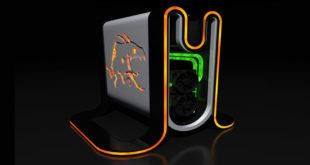1080, 60 – two simple numbers that some believe can spell success or doom for video games.
The technological leap in hardware power between the PS2 generation and the Xbox 360 and PS3 didn’t just bring high definition visuals to console– it also set a new benchmark against which titles would be tried and tested.
1080p is the highest resolution of standard HD displays, which determines how sharp graphics look on-screen. 60 frames-per-second (fps) is the rate action is refreshed, which affects how smooth in-game animations look. Both figures are a common topic of discussion for gamers looking to determine the technological capabilities of the consoles and quality of their titles. The popular pairing of the two factors in a title is commonly referred to as ‘1080p60′.
Andy Tudor (pictured, right), creative director at Project CARS developer Slightly Mad Studios, says that games firms should be aware of the strong influence hitting the ‘1080p60′ sweet spot can have.
Numbers like 1080p and 60fps continue to act as a kind of ‘benchmark’ of how sophisticated and technically-capable your game experience is going to be – either rightly or wrongly,” he explains.
In today’s world it definitely has importance – especially if it’s the deciding factor on which console or which version of a game you’re purchasing.”
Many publishers use the appeal of 1080p60 to tout the visual prowess of their latest titles.
However, failing to match up to consumers’ expectations can have dire consequences; a class action lawsuit was filed against Sony last August by Douglas Ladore, who claimed that the company had falsely advertised the graphical competence of Killzone: Shadow Fall (pictured below). Ladore claimed that the PS4 title had been promoted as running at a native resolution of 1080p, but in reality the title’s multiplayer mode ran at a lower resolution, upscaled to reach 1080p.
A MATTER OF CONTEXT
There will always be a select group of consumers to whom the highest resolution and framerates will take first priority.
Rich Leadbetter, director at performance analysis website Digital Foundry, says that much of the contention over performance arises from the comparison of the stationary hardware of the consoles with the evolving power of PC platforms, with the latter often being restricted to reduced performance as game creators prioritise console development.
The backlash – if there is one – is to do with a 30fps standard being imposed on the PC gaming community,” he explains. Having invested in the hardware to get the experience they want, having artificial limitations imposed in software is a really bad idea.”
He adds that while PC gamers like to focus on top performance, it’s not so crucial to the more casual console consumers.
The success of titles like Watch Dogs and Battlefield 4 on console demonstrates that 1080p isn’t essential for a best-selling title,” he states. Both are 900p on PS4 and lower on Xbox One.
Quite a lot of multi-platform titles run at 900p on Xbox One and 1080p on PS4 – the difference is notable, but not massively important in general living room conditions, where you’re seated two or three metres from the screen.”
"The success of titles like Watch Dogs and Battlefield 4 on console demonstrates that 1080p isn’t essential."
Rich Leadbetter, Digital Foundry
However, Leadbetter continues, some of the biggest games of all time owe their popularity to a certain level of performance – regardless of what platform they are on.
Most players want a fantastic game, and quality gameplay defines a good experience,” he says. Framerate is instrumental to this, but to what extent varies depending on the kind of game.
Some of the biggest-selling gaming franchises – Gran Turismo, Call of Duty and FIFA – are based on 60fps gameplay.For those games, slick, visual feedback and low latency controls are the essence of the gameplay experience – the games wouldn’t play as well at lower framerates.”
While high performance can define a game’s unique appeal, the opposite can also sometimes be true. Recent titles such as Bethesda’s The Evil Within and Sony’s The Order 1886 have deliberately targeted lower framerates to provide a more ‘cinematic’ experience – or, at least, so their creators say.
The argument of lower framerates being more ‘cinematic’ has little merit,” retorts Leadbetter.
Lower framerates are a trade: a compromise. They always have been. A ‘cinematic’ framerate has nothing to do with a better experience for the viewer.
The Order 1886 wouldn’t look as lush as if the framerate were doubled but, similarly, if the PS4 had a bottomless pit of rendering power that allowed [developer] Ready at Dawn to produce whatever visuals they wanted, I doubt that they would limit the framerate to 30fps because it looks ‘cinematic’.”
BEYOND THE FRAME
1080p60 might be a mainstay of the console market for now, but with PC already pushing onto 4K and ultra HD, will it be long beforeplayers start expecting more from their games?
1080p is here to stay for a while yet,” predicts Leadbetter. Because of the diminishing returns at distance, TV manufacturers are going to have problems selling 4K living room displays unless they make them considerably bigger, which is pretty much what happened in the move from standard def screens to HD.
However, I see 4K as a very promising niche market, with a higher degree of relevance to PC gamers.”
Tudor adds: PS4 is already capable of running video at 4K, so it’ll be interesting to see in forthcoming years if support for 4K gaming comes along on console too.
Certainly though, higher resolutions and framerates will continue to be expected as the new standards though.”
There is at least one sector where pushing performance boundaries will be vital.
We should be talking about next-gen more in terms of virtual reality devices,” explains Leadbetter. There, 60fps is the bare minimum fo

 MCV/DEVELOP News, events, research and jobs from the games industry
MCV/DEVELOP News, events, research and jobs from the games industry



